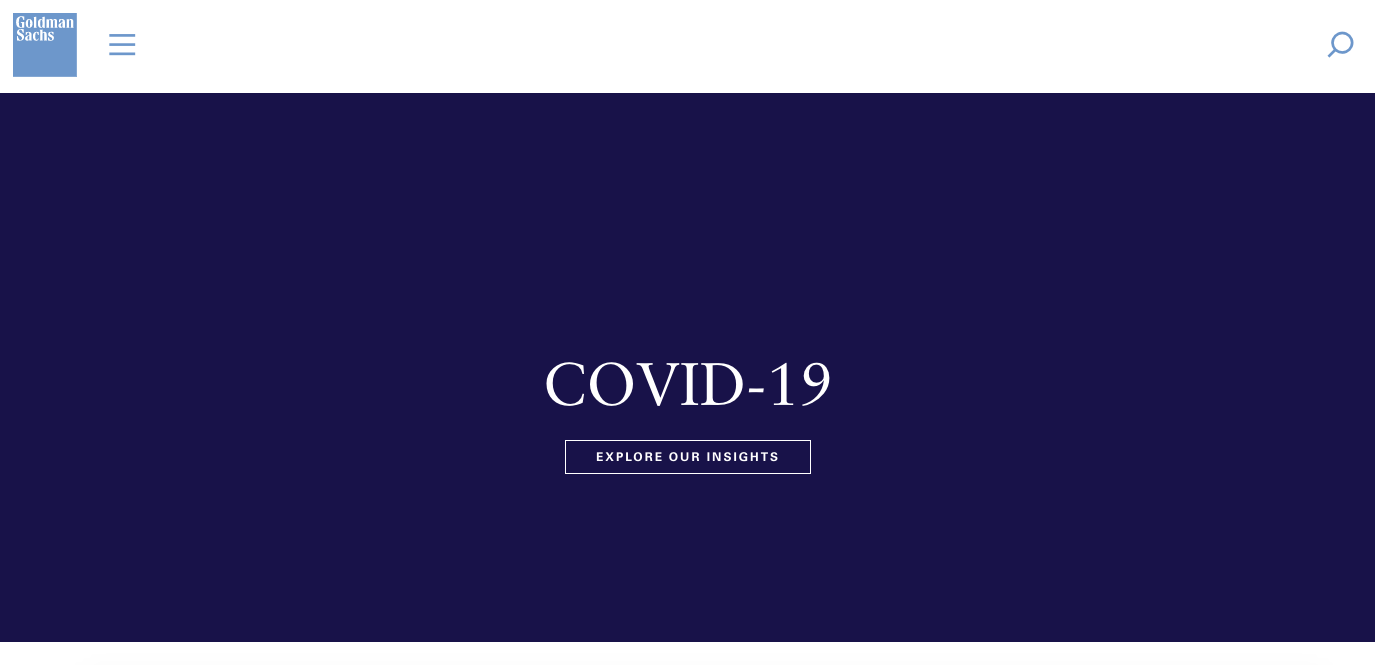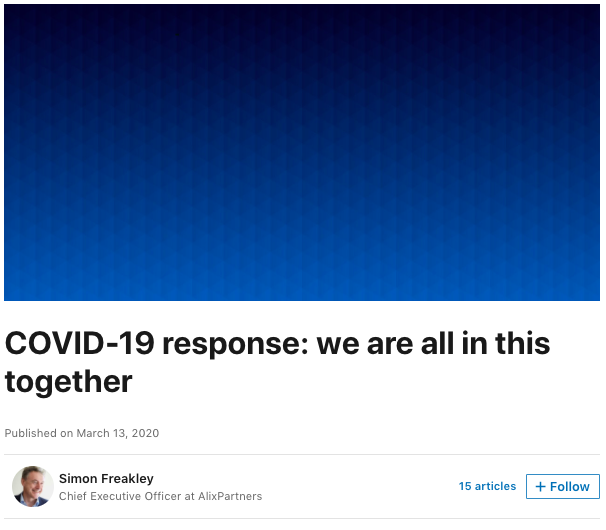As businesses globally adjust to the current uncertainty, marketers need to remain agile and open to changing tact quickly. What worked and was appropriate yesterday, may not be so today. What’s certain is we’re not in ‘business-as-usual’ for the foreseeable future.
Many brands may be pausing marketing spend, some out of sensitivity while they evaluate what messaging and activity is appropriate, but others out of nerves and simply not knowing what’s coming next.
While it is absolutely right to be cautious, and think carefully about any outbound communications at the moment, brands need to start behaving differently – and quickly – from a digital perspective in order to compete in this environment. Digital readiness is key for businesses to maintain relevance and stay competitive.
So how should brands be refocusing and leveraging digital? Much depends on how digitally sophisticated you already are; but whatever your starting point, here are five things to do right now as everyone adjusts to the current environment.
- Understand how your audiences’ behaviors are changing
- Leverage your channels to connect with your audiences authentically
- Reprioritize campaign budgets in response to uncertainty
- Leverage technology to test and learn across new channels and targeting
- Empower your employees to engage online
For tailored advice on how you can adapt your digital marketing strategy to respond to the current disruption, please get in touch.
1. Understand how your audiences’ behaviors are changing
Now, more than ever, it is crucial to be aware of what’s happening in your industry, and how your customers and audiences are talking about it. Take note of what peers and competitors are saying and how audiences are responding.
The volume of search queries around COVID-19 is so high that it’s already being referred to as “the biggest trend in Google search history.” Google Trends provides a quick snapshot of some of the financial and economic topics people are concerned about from unemployment levels to stock market fluctuations.
Beyond search, the level of engagement around the pandemic online is unprecedented – and audiences want it from sources they trust. Major news outlets are seeing record readership and engagement in March, according to the analytics platform Newswhip. As of Monday March 23, Newswhip has seen more than 1.5 billion engagements to around 2.5 million news articles on the topic. For reference, that’s more engagements in one month than publishers have seen in the entirety of their existence.
Sprinklr reported on the explosion of coronavirus-related social media mentions online, reaching a record of nearly 20 million in a day (to put that into context, mentions of Trump hit about four million during the same period). While the majority of these mentions are considered negative (reflecting people’s frustrations and fears), there’s also evidence of audiences looking for information and guidance on what to do. Brands have a responsibility to provide that, if they can do so appropriately and in the context of your business.
As the spread of the virus continues, the online conversation around COVID-19 could remain at peak levels for months. It’s critical to monitor them for your brand, as conversations (and sentiment) within certain topics around your industry will likely shift.
Leverage online listening tools like Brandwatch or Hootsuite to monitor beyond what you can obviously see, setting up targeted search strings to understand what topics and conversations your audiences care about and are engaging in - both related to COVID-19 and more broadly. Automate alerts, so you stay on top of the latest developments. And most importantly, learn from your listening and use these insights to inform your own brand’s communications.
2. Leverage your channels to connect with your audiences authentically
Over the past few years we have seen the rise of the purpose-led brand. We have worked with many of our clients to help them define their own purpose and values, translating that into tangible brand communications.
Now, that emphasis on honesty and transparency is being put to the test. Like all of us, firms don’t know how things will develop or what’s going to happen next, but audiences will appreciate open and genuine digital communications while things remain uncertain.
Brands should leverage owned digital channels to help communicate messages; firms ploughing ahead with BAU and not addressing COVID-19 in any way online look out-of-touch.
Goldman Sachs is a good example. The company’s homepage is now dedicated to a simple, striking banner linking to a hub of latest, related news and insights.

CEOs and other top spokespeople should take the lead. Simon Freakley, CEO of AlixPartners, started a LinkedIn post this month by saying “we are all in this together.” He then explained how they are working as a team to provide help to their clients with guidance on how to approach crisis planning.

The best digital campaigns will be those that continue to tell the brand story while remaining informative and offering guidance, keeping you front of mind during a period when your audience will arguably have more time on their hands to consume content.
Be careful of proceeding ‘as planned’ without adjusting messaging or creative in light of the latest developments. Ads showing crowded locations or gatherings, for example, may not resonate in a landscape of social distancing; CTAs requesting a meeting are likely to put users off completely; and any pre-planned communications around events need to be reconsidered in light of cancellations, or adjusted to the new reality of online conferencing.
Don’t ignore what is going on in the world. But not everything has to become ‘COVID-19’ related. There is space for content that is interesting, useful and a break from the daily virus news cycle.
In certain industries, however, that may not be so appropriate. If you’re targeting any of the industries hardest hit by the disruption—travel, events, aviation—rethink the content or messaging you are going to market with. Remember, authenticity, especially in times like these, is absolutely critical.
Make sure you’re clear on your brand’s standpoint; what you’re saying online should be consistent with your other messaging, both internal and external. Then map out where you need to communicate that across your digital ecosystem, reflecting how your audiences read and engage with your owned content.
3. Reprioritize campaign budgets in response to uncertainty
The availability, cost and impact on results across paid digital channels is still becoming evident.
At the same time, many brands—particularly those in the most affected sectors—are pulling online ad spends. With businesses hit hard, and consumers highly unlikely to convert in the current climate, investment in online advertising, depending on your sector, might not be driving value.
With all of this in mind, to what extent is this an opportunity for brands to reach and engage people via paid marketing? The answer: test and find out.
Interestingly on the Paid Search side, initial stats from WordStream show Financial Services seeing a boost over the last few weeks, with indications that usually high CPCs are falling (notably some of the most expensive keywords in asset management and insurance), while CTRs and CVRs are going up.

Source: WordStream
For those of us running campaigns, we need to closely monitor what that means for competition levels and CPCs, and adjust or optimize accordingly. With one of our current client’s campaigns in the bond space, for example, we’ve seen a 20% increase in CPCs in the last week, but also the same jump in CTR—resulting in an uplift in relevant traffic coming through to the site. In another instance, CPCs are up 39%, while the number of impressions and clicks have dropped as a result.
We do, however, need to be mindful of the decisions being made by the platforms as well. Facebook, Google and others have taken immediate steps to clamp down on paid ads related to COVID-19, in an attempt to counter misinformation and fake news. For Facebook, this means ramping up on their automated enforcement for ads as they have sent home all contract workers who perform manual content reviews.
For advertisers, this means we could face a delayed review for new ad approvals, or potentially see an increase in ads being incorrectly disapproved (and, for those familiar with Facebook ads, this is not the easiest process to navigate at the best of times).
Keep a close eye on current campaign activity over the coming days and weeks, pausing, optimizing and adjusting budgets as needed. And don’t be afraid to test the water and try new channels and tactics; leverage the huge amount of data available across each platform to identify where your audiences are and inform your testing approach.
4. Leverage tech to test and learn across new channels and targeting
With more of us now staying at home, there will be more eyeballs locked on screens than ever before, as we embrace online channels as a way of doing business, keeping up to date, and connecting with friends, family and colleagues.
For brands that have a sophisticated digital infrastructure, it should be a relatively easy transition to focus on digital marketing versus in-person activations and events. But being “digitally ready” as a brand means you not only have the right people in place, but also the right technology, tools, and culture of agility.
If your brand is not digitally ready, it’s time to get the basics in order – fast. Consider your culture, team, and technology. Dust off your social channels and CRM lists and build your digital ecosystem. Start publishing and thinking about your search optimization.
If your brand is digitally ready, now’s the time to test and learn across new channels and targeting. Having a test-and-learn mentality sets an organization up to be agile, which is the foundation of digital readiness and key in times of uncertainty.
For instance, this could be a good time to generate impressions and engagement on previously under-utilized channels, such as Facebook, YouTube, or Google Ads – while audiences are looking for uplifting content to distract them from the ongoing COVID-19 news cycle. Facebook, for example, has reported significant surges in usage well above the spikes it normally sees only annually on New Year’s Eve. Even as a B2B brand, it might be a channel to test.
Now is also a good time to make sure you’ve got the right tracking in place to build remarketing lists. Audiences may not be ready to convert right now, but in a few weeks time that might be a different story and you should be ready to repromote relevant content and messaging out to those who are already engaged with your brand.
It’s also a good time to make sure your digital house is in order. SEO is a long-term game, so make sure you don’t neglect efforts there now and risk falling behind. When it comes to paid search, best practice advice is to simply add ‘Coronavirus’ and ‘Covid-19’ as negative keywords - just to be safe.
Use this time to audit your brand’s digital footprint and make sure you’ve got the right foundations to stay agile as the situation evolves.
5. Empower your employees to engage online
While your target audiences are primarily now at home and online, remember the same is true of your own employees. Now is the time to maximize and empower restrained resources.
For some, maintaining professional connections and engagement online comes naturally. For others, particularly non-’digital-natives,’ it can feel like a minefield to navigate.
Make sure you have clear guidelines in place to inform how your team can, and should, leverage social media in a professional capacity. Set the parameters around what not to do, but crucially empower people with the confidence to share and engage when appropriate. And if they’re not too comfortable with social media, now’s the time to train them.
LinkedIn, particularly, is a hugely powerful way to identify and build new sales opportunities, wherever you are, in addition to simply engaging with people you already know. Content shared by employees has an average 2x higher engagement rate than that shared by companies.
Twitter, when used effectively, can be a great way to connect with journalists and join in discussions around industry events that have moved online.
Ensure you have the right technology in place to enable your teams to sell and build client relationships remotely. There are many remote-working tools available today (and so many ‘top 10 lists’ at the moment), to facilitate effective online relationship building.
Tailored digital and social training is easy to develop and deliver to remote, global teams - and the benefits will last long past the current crisis. If this is new for your team, start with basic channel best practices and make sure users know how to optimize their profiles and share content. For more advanced groups, dive into the detail of targeted social selling and relationship management.
Enable your employees to sell and connect online by having the right infrastructure, training, and guidelines in place.


